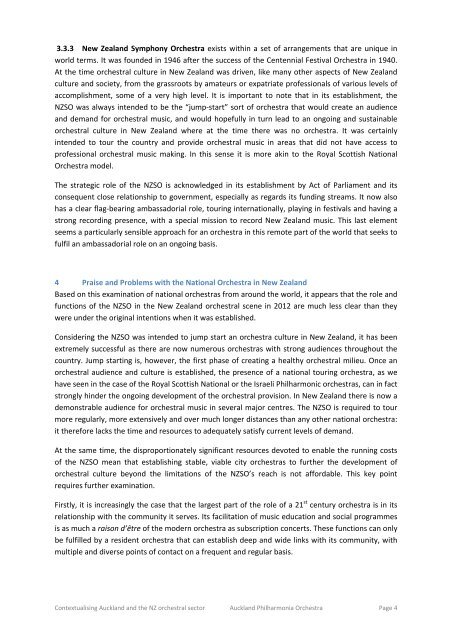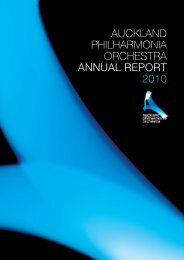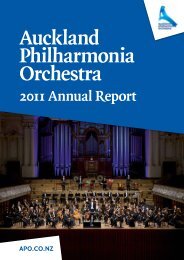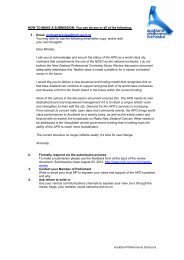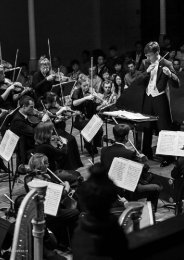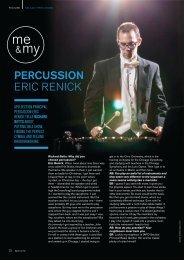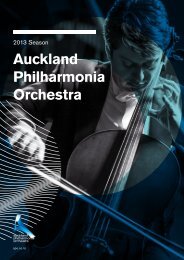Auckland Philharmonia Orchestra - the Auckland Philharmonia
Auckland Philharmonia Orchestra - the Auckland Philharmonia
Auckland Philharmonia Orchestra - the Auckland Philharmonia
You also want an ePaper? Increase the reach of your titles
YUMPU automatically turns print PDFs into web optimized ePapers that Google loves.
3.3.3 New Zealand Symphony <strong>Orchestra</strong> exists within a set of arrangements that are unique inworld terms. It was founded in 1946 after <strong>the</strong> success of <strong>the</strong> Centennial Festival <strong>Orchestra</strong> in 1940.At <strong>the</strong> time orchestral culture in New Zealand was driven, like many o<strong>the</strong>r aspects of New Zealandculture and society, from <strong>the</strong> grassroots by amateurs or expatriate professionals of various levels ofaccomplishment, some of a very high level. It is important to note that in its establishment, <strong>the</strong>NZSO was always intended to be <strong>the</strong> “jump‐start” sort of orchestra that would create an audienceand demand for orchestral music, and would hopefully in turn lead to an ongoing and sustainableorchestral culture in New Zealand where at <strong>the</strong> time <strong>the</strong>re was no orchestra. It was certainlyintended to tour <strong>the</strong> country and provide orchestral music in areas that did not have access toprofessional orchestral music making. In this sense it is more akin to <strong>the</strong> Royal Scottish National<strong>Orchestra</strong> model.The strategic role of <strong>the</strong> NZSO is acknowledged in its establishment by Act of Parliament and itsconsequent close relationship to government, especially as regards its funding streams. It now alsohas a clear flag‐bearing ambassadorial role, touring internationally, playing in festivals and having astrong recording presence, with a special mission to record New Zealand music. This last elementseems a particularly sensible approach for an orchestra in this remote part of <strong>the</strong> world that seeks tofulfil an ambassadorial role on an ongoing basis.4 Praise and Problems with <strong>the</strong> National <strong>Orchestra</strong> in New ZealandBased on this examination of national orchestras from around <strong>the</strong> world, it appears that <strong>the</strong> role andfunctions of <strong>the</strong> NZSO in <strong>the</strong> New Zealand orchestral scene in 2012 are much less clear than <strong>the</strong>ywere under <strong>the</strong> original intentions when it was established.Considering <strong>the</strong> NZSO was intended to jump start an orchestra culture in New Zealand, it has beenextremely successful as <strong>the</strong>re are now numerous orchestras with strong audiences throughout <strong>the</strong>country. Jump starting is, however, <strong>the</strong> first phase of creating a healthy orchestral milieu. Once anorchestral audience and culture is established, <strong>the</strong> presence of a national touring orchestra, as wehave seen in <strong>the</strong> case of <strong>the</strong> Royal Scottish National or <strong>the</strong> Israeli Philharmonic orchestras, can in factstrongly hinder <strong>the</strong> ongoing development of <strong>the</strong> orchestral provision. In New Zealand <strong>the</strong>re is now ademonstrable audience for orchestral music in several major centres. The NZSO is required to tourmore regularly, more extensively and over much longer distances than any o<strong>the</strong>r national orchestra:it <strong>the</strong>refore lacks <strong>the</strong> time and resources to adequately satisfy current levels of demand.At <strong>the</strong> same time, <strong>the</strong> disproportionately significant resources devoted to enable <strong>the</strong> running costsof <strong>the</strong> NZSO mean that establishing stable, viable city orchestras to fur<strong>the</strong>r <strong>the</strong> development oforchestral culture beyond <strong>the</strong> limitations of <strong>the</strong> NZSO’s reach is not affordable. This key pointrequires fur<strong>the</strong>r examination.Firstly, it is increasingly <strong>the</strong> case that <strong>the</strong> largest part of <strong>the</strong> role of a 21 st century orchestra is in itsrelationship with <strong>the</strong> community it serves. Its facilitation of music education and social programmesis as much a raison d’être of <strong>the</strong> modern orchestra as subscription concerts. These functions can onlybe fulfilled by a resident orchestra that can establish deep and wide links with its community, withmultiple and diverse points of contact on a frequent and regular basis.Contextualising <strong>Auckland</strong> and <strong>the</strong> NZ orchestral sector <strong>Auckland</strong> <strong>Philharmonia</strong> <strong>Orchestra</strong> Page 4


